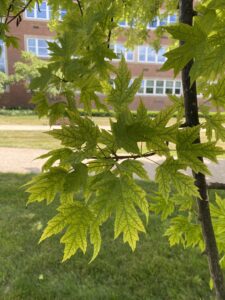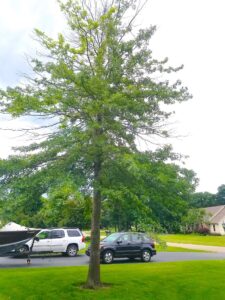The maintenance of plants in the urban landscape is demanding at times. The many challenges that imperil trees in the urban forest are numerous and increasing. Plant Health Care requires education, experience, and credible resources to make informed decisions on plant interventions. These skills are needed especially for understanding and recognizing nutritional requirements as well.
Trees can’t really tell us what is wrong, so, we rely on the expression of symptoms and identification of signs to differentially diagnose the causal agent or agents. Our first, and most intuitive diagnostic step is typically through visual associations when we notice a plant with a less than healthy presence. This includes a comparative recognition of appearances considered typical against atypical representations of the plant. Commonly, this results in identifying leaf discoloration such as yellowing of the live tissue or specific chlorotic patterns and that is all we get for nutrient deficiencies, and it just isn’t enough. Often leaf tissue analysis detects fertilization problems within an existing program. Someone may be applying a fertilizer product, but the plant may not be responding as expected which indicates availability issues. Trees and their growing environment differ even within the same site and cannot be managed collectively and expect results. Individual cohorts may require specific PHC needs.
The PHC predicament is simply “Are you capable of making an informed decision with a visual identification regarding nutrient deficiencies? Simply, the answer is no. Responsible, ethical plant health care requires critical thinking which engages the best resources and application of the solution. First, this requires identifying the appropriate testing methodology for nutrient deficiencies and pH as well as an understanding of how the law of minimums can apply to plant health and nutrition.
When agricultural scientists centuries ago began to realize mineral elements in a plant were taken up from the soil in which the plants grow, it was a logical step to suggest that chemical analysis of plants could be used as a means of assessing the nutrient supply of the soil. At the time it also appeared reasonable to suggest, as von Liebig did in the last century in his Law of Restitution. This premise suggests that plant analysis could be used to determine the quantities of nutrients removed from the soil by a crop and, therefore, the amounts needed to maintain the supplying power of the soil. Justus von Liebig’s Law of the Minimum states that yield (growth) is proportional to the amount of the most limiting nutrient, whichever nutrient it may be. From this, it may be inferred that if the deficient nutrient is supplied, yields (growth) may be improved to the point that some other nutrient is needed in greater quantity than the soil can provide, and the Law of the Minimum would apply in turn to that nutrient. (van der Ploeg, R., Böhm, W. and Kirkham, M. (1999), On the Origin of the Theory of Mineral Nutrition of Plants and the Law of the Minimum. Soil Sci. Soc. Am. J., 63: 1055-1062).
Basically, all plant growth is regulated by its greatest need or the nutrient in the shortest supply regardless of the abundance of other nutrients. Some soils have the necessary essential elements but, supplementation may be needed to overcome deficient soils or enhance growth.
Various factors affecting availability include soil type, pH, cation exchange capacity (CEC) and water holding capacity (WHC). Understanding soil properties allows us to better diagnose for a more prescriptive solution to deficiencies often found in urban soils.
It is estimated that less than 2% of a tree’s materials are derived from essential elements taken from a soil. Failure to obtain all essential items lead to primary deficiencies, secondary symptoms, and metabolic dysfunction (White, P. J., & Brown, P. H. (2010). Plant nutrition for sustainable development and global health. Annals of botany, 105(7), 1073–1080).
The formula for maintaining a healthy, sustainable tree depends upon specific application of essential elements. Essential elements in excess or inadequacies can lead to minor health issues at least, or devastating failure and even death in worst cases.
Soil analysis is helpful in formulating and improving a fertilization program because soil testing measures organic matter content, pH, and extractable nutrients. Soil analysis is particularly useful when conducted for several consecutive years because trends can be observed. However, plant health care professionals cannot rely on soil analysis alone to formulate a fertilizer program or to diagnose a nutritional issue in the landscape.
Diagnosis of potential nutritional problems should be a common practice. Quantifying nutrients in soils and trees eliminates guesswork when adjusting a fertilizer program. Elemental deficiency or surplus causes trees to grow poorly or affects them negatively in other ways. However, soil tests aren’t the only or singular option for nutrient deficiencies. Soil testing and leaf tissue analysis do not assess all the same factors, so care must be taken to choose the correct test when diagnosing nutritional concerns.
Leaf tissue analysis is a very useful tool to detect problems more specifically and adjust fertilizer programs for trees and shrubs because leaf nutrient concentrations are the most accurate indicator of any plant nutritional status. Considerable research involving leaf testing has established its reliability as a management tool, but sampling guidelines should be followed precisely to ensure that analytical results are meaningful.
Leaf tissue analysis tests all the factors which influence nutrient availability and uptake. Tissue analysis shows the relationship of nutrients to each other as well. For example, K deficiency may be from a lack of K in the soil or from excessive Ca, Mg, and/or sodium (Na). Similarly, adding N when K is low may result in K deficiency since the increased growth caused by N requires more K. There are many nutrient interactions when it comes to prescriptive nutrition programs. Effective PHC requires knowledge of these interactions to prevent compounding problems. This could be considered similar to drug interactions within people and their prescriptions.
Comparatively, Leaf analysis is a useful tool to detect problems because leaf nutrient concentrations are the most accurate indicator of crop nutritional status. Leaves reflect nutrient accumulation and redistribution throughout the plant, so the deficiency or excess of an element in the soil is often reflected in the leaf.
Soil tests are quite useful for pH, organic matter content and other qualities. Relative to nutrition, soil tests primarily measure extractable elements present in the sample. However, it doesn’t measure the total amount of nutrients present nor the quantity actually available to the tree.
- Finally, a sampling or testing program can be most effective if conducted annually, especially on problem plantings. Leaf tissue testing is valuable for all elements. Soil testing is most useful for consideration of pH, P, Ca, Mg, and Cu concentrations. A key point is visual identification tools are unreliable because virtually every deficiency reveals similar expressions of chlorosis. There are some key points to remember when sampling for tests to get best results. Pesticide spray residues on leaf surfaces affect sample results be sure to wash leaves for accurate analysis. Especially avoid sampling recently treated trees.
- Interpretation of leaf and soil tests should be used to make fertilizer or supplement decisions. A broad-spectrum or “shotgun” approach is never accurate, less effective, and often not economical either. Wise use of the results allows optimal health and growth and minimizes environmental impacts and reduces fertilizer waste with inaccurate applications.


